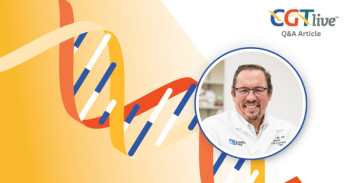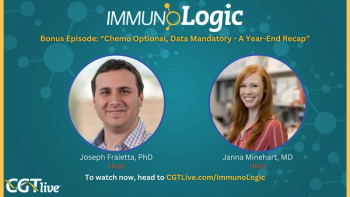
FDA Grants Abatacept Breakthrough Designation for Acute GVHD
The FDA has granted a breakthrough therapy designation for abatacept for the prevention of moderate-to-severe acute graft-versus-host disease in patients who have undergone hematopoietic stem cell transplants from unrelated donors.
Leslie Kean, MD
The FDA has granted a breakthrough therapy designation for abatacept (Orencia) for the prevention of moderate-to-severe acute graft-versus-host disease (GVHD) in patients who have undergone hematopoietic stem cell transplants (HSCTs) from unrelated donors.1
The designation is based on results of a phase II investigator-initiated trial, in which the impact of abatacept was evaluated for the prevention of severe acute GVHD when added to a standard GVHD prophylactic regimen in patients with hematologic malignancies receiving a stem cell transplant from an unrelated, HLA-matched or mismatched donor.
“While ideally we prefer using fully matched transplants from a sibling for the treatment of hematologic cancers, only the minority of patients have such a sibling,” lead study investigator Leslie Kean, MD, director of the Stem Cell Transplantation Program, Dana-Farber/Boston Children's Cancer and Blood Disorders Center, stated in a press release. “A therapy that lowers the risk of GVHD in unrelated stem cell transplants would potentially allow more patients to receive a transplant, which typically is the last option to treat hematologic cancers after other therapies have been used unsuccessfully.”
Currently, there are no FDA-approved treatments for the prevention of acute GVHD, which can impact patients who are receiving hematopoietic stem cell transplants treatment of certain genetic diseases and hematologic malignancies. Transplant infusions include donor T cells, and GVHD occurs when these T cells recognize healthy cells as foreign and attack healthy tissues and organs. T-cell activation requires co-stimulation, and abatacept, which is currently indicated as a treatment for patients with various arthritic conditions, binds to and inhibits protein targets involved in co-stimulation, and inhibits T-cell activation, stated Bristol-Myers Squibb (BMS), the developer of abatacept, in the press release.
In the multicenter, double-blind, randomized, phase II ABA2 trial, investigators evaluated the safety and tolerability of the addition of abatacept to a GVHD-prophylaxis regimen of a calcineurin inhibitor and methotrexate in 186 patients. There were 2 cohorts: HLA-mismatched (cohort A; n = 43), which was a single-arm trial with prespecified CIBMTR matched analysis versus anti-thymocyte globulin (ATG) plus a calcineurin inhibitor and methotrexate, versus calcineurin inhibitor (CNI) and methotrexate alone; or HLA-matched (cohort B; n = 142), which was a randomized, double-blind cohort of abatacept plus the prophylactic regimen versus the prophylactic regimen plus placebo.
In each arm containing abatacept, patients received 4 doses of the treatment at 10 mg/kg on days 1, 5, 14, and 28.
To be eligible for enrollment, patients must have been ≥6 years old and weighed ≥20 kg and had a willing unrelated adult donor. Those who had prior allogeneic HSCT, had an available HLA identical related donor, HIV infection, a known inherited or constitutional predisposition to cancer, an estimated GFR <50 mL/min/1.73 m2, a Karnofsky performance score or Lansky Play-Performance Scale score <80, and presence of antibodies to a mismatched donor HLA antigen were some of the exclusion criteria.
The primary endpoint is cumulative incidence of severe acute GVHD at day 100 posttransplant in the standard and investigational arms; secondary endpoints are cumulative incidence of serious infection, engraftment, relapse, and overall survival (OS); comparison of severe acute GVHD-free survival up to day +180 posttransplant; and comparison of cumulative incidence of severe grade 3/4 acute GVHD up to day +180 posttransplant.
Results of the trial were presented at the 2019 Biology of Bone and Marrow Transplantation Annual Meeting.2 In cohort A, the rates of grade 3/4 acute GVHD were 2.5% with abatacept versus 31% with CNI/methotrexate alone, and 22% with CNI/methotrexate plus ATG (1-sided P = .001; .005). In cohort B, the rates of grade 3/4 acute GVHD were 6.85% with abatacept compared with 14.6% with placebo (1-sided P = .068).
Abatacept added to the prophylaxis regimen also was found to reduce grade 2 to 4 acute GVHD in cohort B at 44.5% versus 62.3% with placebo (1-sided P = .004). In cohort A of HLA-mismatched patients, the grade 2 to 4 acute GVHD rates were 42% with abatacept, 54% with CNI plus methotrexate alone, and 45% with CNI/methotrexate plus ATG (1-sided P = .098; 0.25).
The 1-year chronic GVHD rates were 38.8%, 43.5%, and 35.5% with the abatacept regimen, CNI/methotrexate, and CNI/methotrexate plus ATG, respectively, in cohort A. In cohort B, investigators noted that the follow-up is not long enough to evaluate.
The relapse rate was also lower the addition of abatacept in both cohorts. In the HLA-mismatched group, abatacept had a 9.37% relapse rate at 1 year, compared with 12.9% and 13.6% with CNI/methotrexate and CNI/methotrexate with ATG (P = .115; .085). In the HLA-matched group, the 1-year relapse rates were 13.8% versus 20.5% (P = .7) with abatacept and placebo, respectively. No relapses were reported at a median 708 days with cohort A, in which the 2-year relapse rate was 9.37% with abatacept, 20.63% with CNI/methotrexate, and 23.4% with CNI/methotrexate plus ATG.
The abatacept addition to the prophylaxis regimen was also associated with a survival advantage. In the HLA-mismatched group, the overall survival rate was 71% for abatacept versus 47.5% for those who received CNI/methotrexate versus 58% for those who received CNI/methotrexate plus ATG (P = .01; .145). In cohort B, the OS rates were 83.2% and 76.6 with abatacept and placebo, respectively (P = .32).
In cohort A, the 1-year transplant-related mortality (TRM) rate was 10.5% with abatacept, 32.7% with CNI/methotrexate, and 26% with CNI/methotrexate plus ATG (P = .024; .365). In cohort B, the 1-year TRM rates were 7.1% with abatacept and 14.6% with placebo (P = .5)
Additionally, relapse-free survival (RFS) was also improved with abatacept. In cohort A, the RFS rate was 73.7% with abatacept, versus 38.7% with CNI/methotrexate, versus 48.7% with CNI/methotrexate plus ATG (P = .001; .027). In cohort B, the RFS rates were 79.1% and 64.9% for abatacept and placebo, respectively (P = .38).
“We are excited about the potential of Orencia to improve outcomes for patients receiving unrelated stem cell transplants. We believe the data could lead to an expansion of the donor pool for stem cell transplants in some patient populations where fully matched unrelated donor transplants have rarely been available,” Brian Gavin, PhD, development lead, Orencia, of BMS, stated in the press release. “We look forward to working with the FDA and making Orencia the first approved therapy for the prevention of acute GVHD.”
References
- Bristol-Myers Squibb announces U.S. FDA breakthrough therapy designation for Orencia® (abatacept) to help prevent acute graft-versus-host disease, a potentially life-threatening complication after stem cell transplant. Bristol-Myers Squibb. Published December 4, 2019. https://bit.ly/2PcCHmn. Accessed December 4, 2019.
- Watkins BK, Qayed M, Bratrude B, et al. T cell costimulation blockade with CTLA4-Ig (abatacept) for acute GVHD prevention in HLA matched and mismatched unrelated donor transplantation: results of the first phase 2 trial. Bio Blood Marrow Trans. 2019;25(3):S51-S52. doi: 10.1016/j.bbmt.2018.12.129.
Newsletter
Stay at the forefront of cutting-edge science with CGT—your direct line to expert insights, breakthrough data, and real-time coverage of the latest advancements in cell and gene therapy.





































